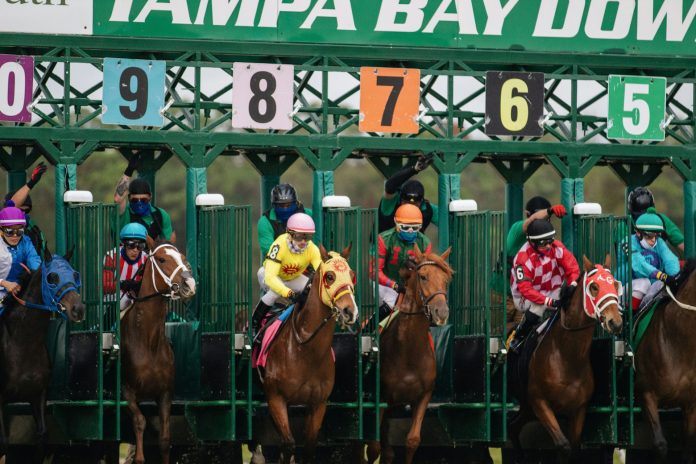On the first Saturday in May, the United States will celebrate the 150th renewal of its longest continually-running sports event, the Kentucky Derby.
Over the past century and a half, nothing has managed to stop the Derby in its tracks. The race has survived every major world event that has transpired since 1875. On two occasions the race was delayed- World War II pushed the 1945 running into June, and the Covid-19 pandemic moved the 2020 edition to September- but cancellation has never been seriously considered.
What makes the Kentucky Derby so special? Let’s take a look at the history of the famed race and see how it has tied itself into American history.
The Importance Of The Epsom Derby
Colonel Meriweather Lewis Clark wanted to raise the prestige of racing in his home state of Kentucky. To do so, he decided to tour Europe and study some of their most famous races, so that he could emulate them once he returned home. While in Europe, he witnessed at least one running of the most famous horse race in the world- England’s Epsom Derby. Clark knew that he had to make his own version of this race, and so the idea of the Kentucky Derby was born.
The Epsom Derby is nearly a full century older than the Kentucky Derby, having first been run in 1780. The race was designed to show off the best three-year-olds of both sexes, and it delivered. The race was popular instantly, and horsemen all over England- and eventually the world- soon made winning the Derby one of their life’s goals.
There are a few key differences between the Epsom Derby and the Kentucky Derby. First and foremost, as with all races in Europe, the Epsom Derby is run on grass instead of dirt. European races are also run in a clockwise direction, whereas American races are run counter-clockwise. The traditional distance of the Epsom Derby is 1 ½ miles (though the first few runnings were at one mile), and while that was the original distance of the Kentucky Derby, it was shortened to 1 ¼ miles in 1895. On a more whimsical note, the Kentucky race is pronounced “DUR-bee,” while the English variety is pronounced “DAR-bee.”
However, more important are the similarities between the two races. Both are races open to male and female Thoroughbreds in the late spring of their three-year-old year. This means that the horses competing are just entering the prime of their careers, but it also means that each horse only ever gets one shot at eternal Derby glory. Knowing that there is only one opportunity for a talented horse to contest the prestigious race, in both cases, adds a sense of urgency for owners and trainers to take their shot.
The Efforts Of Colonel Matt Winn
The early runnings of the Kentucky Derby were popular and successful, but a series of misfortunes, including the perceived snubbing of James Ben Ali Haggin as well as the rise of anti-gambling sentiment nationwide, caused the Kentucky Derby to fall into a bit of a slump by the end of the nineteenth century.
Colonel Matt Winn, who had witnessed the inaugural Kentucky Derby from the back of his father’s pickup truck, fell in love with the event and made it his life’s goal to promote and grow the race. He purchased Churchill Downs in a partnership in 1902, and financially saved the Kentucky Derby in 1908.
Bookmakers had just been banned by law, and without a stream of income from gambling, it was feared that the track would have to be closed down. However, Winn discovered that a statute in the law would permit gambling to take place if done through parimutuel betting machines. Winn was able to secure and install enough of those machines just in time for Derby day. Find information here: twinspires.com/kentuckyderby/winners/
The Prestige Of High-Class Owners
With Matt Winn at the helm, the Kentucky Derby was growing in prestige, but the biggest boost came from the owners who decided to run their best horses in the race.
This attitude was most perfectly encapsulated in 1915. Harry Payne Whitney was one of the greatest horsemen in America at the time. He owned a blazingly fast filly named Regret, considered to be the best two-year-old of either sex in 1914. He decided to try his filly in the Kentucky Derby, and she rewarded him by becoming the first female to win the race.
As she was being fawned over in the winners’ circle, Whitney was quoted as saying “I don’t care if she never wins another race, nor starts in another. She has won the greatest race in America and I am satisfied.”
At that moment, the Kentucky Derby’s place in history was sealed.
The Value Of Tradition
Since then, the Kentucky Derby has continued to shape American Thoroughbred racing. Now, no longer is the race merely a way to show the best horses and build the future of the sport; it is an important link to our past. Since Regret blazed across the finish line in 1915, remarkably little has changed about the race.
Technological advances such as starting stalls, photo finish cameras, television broadcasts, and racing apps have enhanced the overall experience, but the race itself is still more or less the same. This connection to the roots of the history of the sport- and the country as a whole- make the Kentucky Derby the national treasure that it is today.

